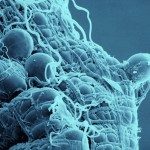Link to Pubmed [PMID] – 25283802
Infect. Genet. Evol. 2014 Dec;28:715-24
During their immature life stages, malaria mosquitoes are exposed to a wide array of microbes and contaminants from the aquatic habitats. Although prior studies have suggested that environmental exposure shapes the microbial community structure in the adult mosquito, most reports have focused on laboratory-based experiments and on a single mosquito epithelium, the gut. In this study, we investigated the influence of the breeding site on the development of the Anopheles coluzzii and Anopheles gambiae microbiota in natural conditions. We characterized bacterial communities from aquatic habitats, at surface microlayer and subsurface water levels, to freshly emerge adult mosquitoes using multiplexed 16S rRNA gene pyrosequencing and we separately analyzed the microbiota associated with the different epithelia of adult individual, midguts, ovaries and salivary glands. We found that the distribution of bacterial communities in the aquatic habitats differed according to the depth of water collections. Inter-individual variation of bacterial composition was large in larvae guts but adult mosquitoes from a same breeding site shared quite similar microbiota. Although some differences in bacterial abundances were highlighted between the different epithelia of freshly emerged An. coluzzii and An. gambiae, an intriguing feature from our study is the particular similarity of the overall bacterial communities. Our results call for further investigations on the bacterial population dynamics in the different tissues to determine the distinctive characteristics of each microbiota during the mosquito lifespan and to identify specific interactions between certain key phyla or species and the insect life history traits.

